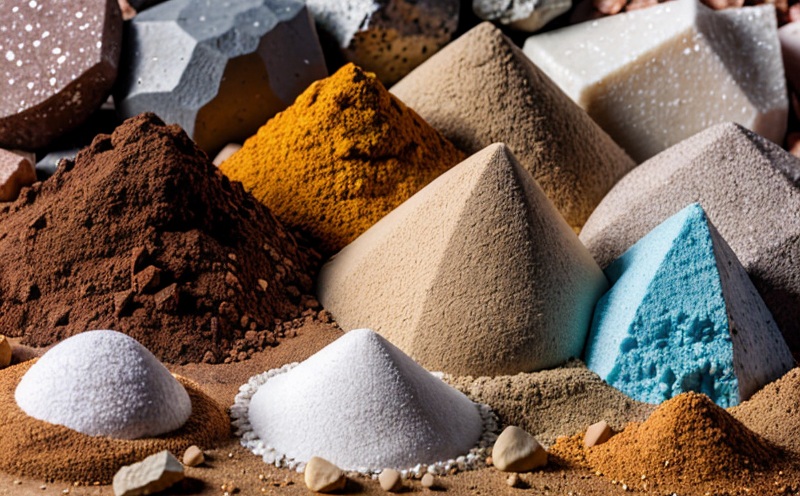ISO 12677 XRF Chemical Analysis of Refractory Ores Testing
The ISO 12677 standard outlines a method for the quantitative analysis of chemical composition in refractory ores using X-ray fluorescence (XRF) spectroscopy. This testing service is essential for quality managers, compliance officers, R&D engineers, and procurement professionals working within the mining sector. Refractory ores are critical raw materials that form the basis of many industrial processes, including steel production, cement manufacturing, and ceramics.
Refractory ores typically contain complex mixtures of oxides, silicates, and other compounds. Accurate analysis is crucial for ensuring consistent quality in these minerals, which directly impacts the performance and efficiency of downstream processes. The ISO 12677 method provides a non-destructive means to analyze elements such as aluminum, calcium, iron, silicon, titanium, and others that are present at trace levels.
The XRF technique leverages X-rays to excite atoms within the sample, causing them to emit characteristic radiation. The energy of this radiation is unique to each element, allowing for precise identification and quantification. This service ensures that the chemical composition aligns with specified requirements set by industry standards or customer specifications.
Our laboratory adheres strictly to ISO 12677 guidelines, ensuring accurate, repeatable, and reliable results. Specimen preparation involves grinding the ore sample into a fine powder to ensure uniformity across all test samples. This step is critical as it minimizes variability in the analysis process.
The XRF spectrometer used for this service features advanced technology capable of detecting even minute concentrations of elements within the refractory ores. The instrument operates over a broad energy range, covering multiple elements simultaneously. Data collected during testing is then processed to produce detailed reports detailing element concentrations and their respective uncertainties.
By adhering strictly to ISO 12677, our laboratory guarantees that every test conducted meets the highest industry standards. This ensures confidence in both internal decision-making processes as well as external reporting requirements for stakeholders such as clients or regulatory bodies.
Applied Standards
- ISO 12677: Quantitative determination of chemical composition by X-ray fluorescence spectroscopy
The ISO 12677 standard specifies procedures for quantitative analysis using XRF spectrometry, which is particularly useful in the examination of refractory ores. This method allows for rapid and precise determination of elemental compositions without requiring destructive sample preparation methods.
By following this international standard, our laboratory ensures consistency and accuracy across all tests conducted on refractory ores. Compliance with ISO 12677 helps maintain industry best practices while providing reliable data that can be trusted by clients seeking assurance about the quality of their raw materials.
Eurolab Advantages
- Experienced and qualified technical staff with extensive experience in refractory ore analysis
- State-of-the-art XRF spectrometers capable of detecting trace elements with high precision
- Robust quality control measures ensuring consistent results across multiple tests
- Comprehensive reporting capabilities providing detailed insights into elemental composition and associated uncertainties
Our laboratory offers several advantages over other providers when it comes to ISO 12677 XRF chemical analysis of refractory ores. Our team comprises highly skilled professionals who have extensive experience in this field, ensuring accurate and reliable results every time.
We invest heavily in cutting-edge equipment that allows us to provide precise measurements even for very small quantities of elements present within the sample. This capability is crucial given the nature of refractory ores, which often contain numerous trace elements at low concentrations.
Our robust quality control processes ensure that each test conducted meets stringent standards, thereby maintaining consistency and reliability in our results. Finally, we offer comprehensive reporting services that provide more than just numerical values; they also include detailed explanations about the significance of these findings within the broader context of industrial applications.
Use Cases and Application Examples
- Determining compliance with regulatory requirements for specific ore grades
- Assisting in R&D initiatives aimed at optimizing the extraction process of valuable minerals from refractory ores
- Supporting procurement decisions by validating supplier claims regarding the purity and composition of delivered materials
- Monitoring production processes to ensure consistency in product quality throughout different stages of manufacturing
The application of ISO 12677 XRF chemical analysis extends beyond mere compliance; it plays a pivotal role in driving innovation within the mining sector. For instance, R&D teams often rely on this service to explore new techniques for extracting valuable metals from challenging ore bodies.
Procurement departments benefit greatly from having independent third-party verification of supplier claims regarding ore purity and composition. This helps reduce risks associated with substandard materials entering the supply chain, ultimately improving overall product quality.
In production environments, continuous monitoring enables operators to make real-time adjustments aimed at maintaining optimal operating parameters without compromising on safety standards or environmental considerations.





